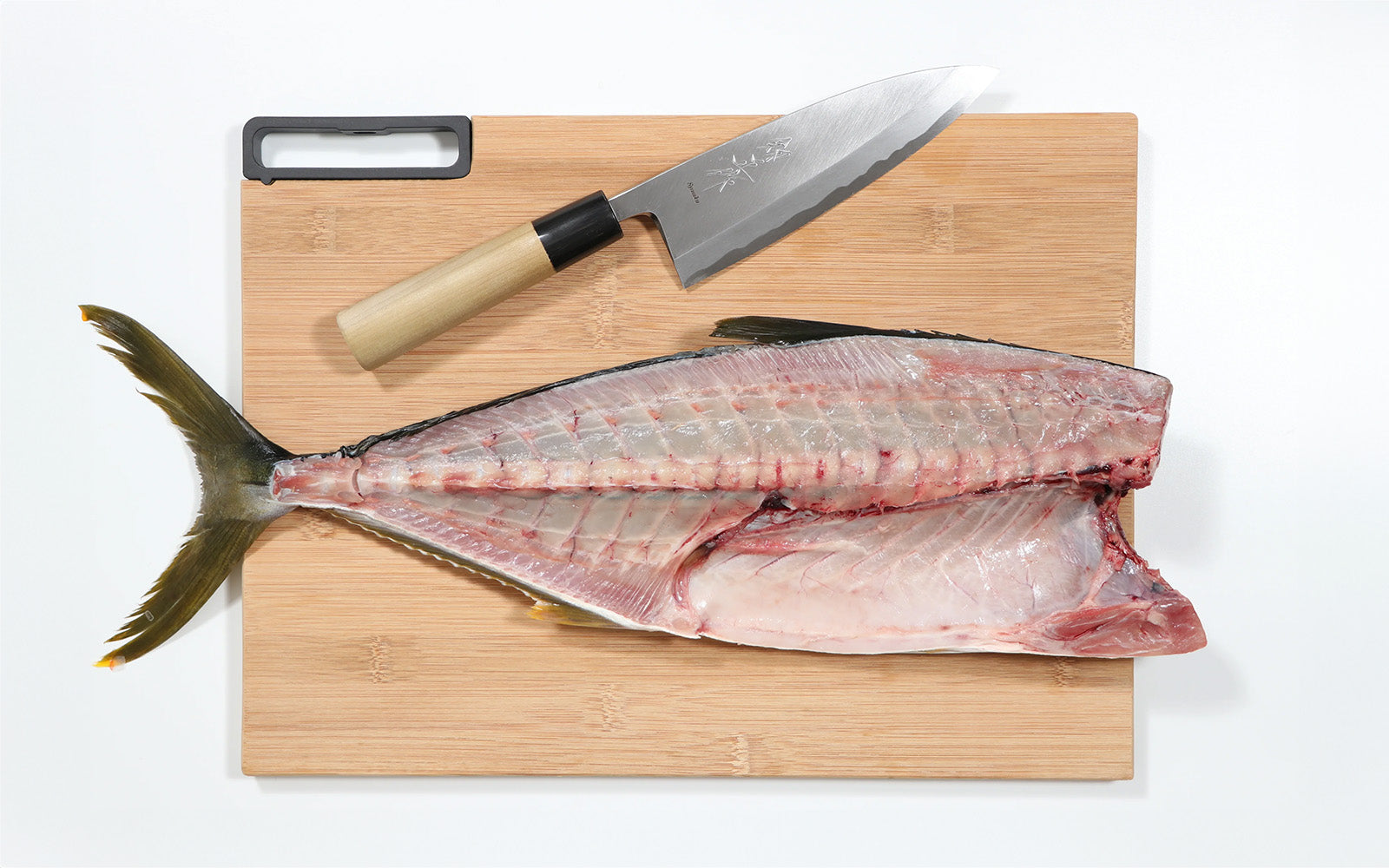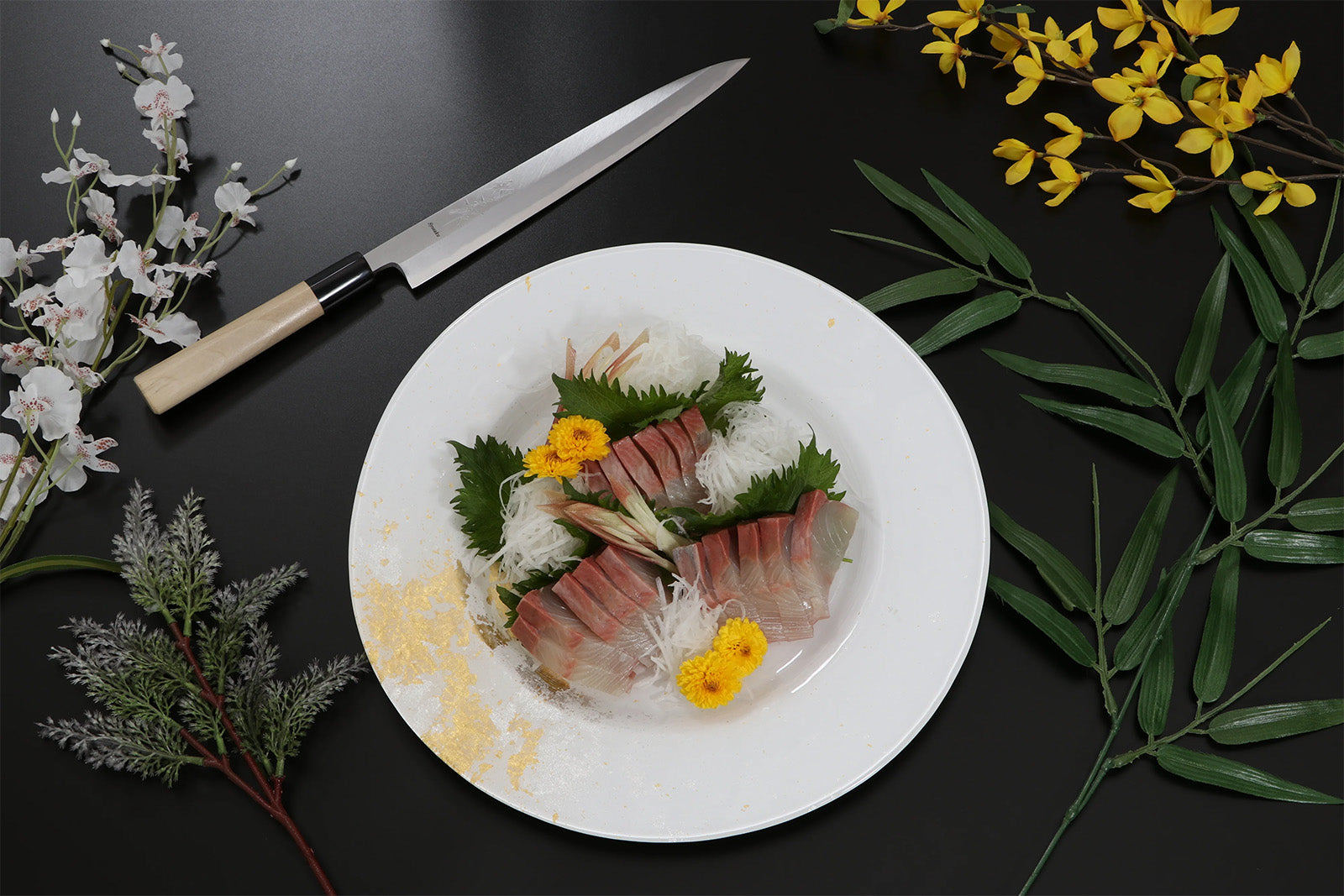
Profile of the Japanese kitchen knife blades
If you laugh at a question, "do you have a knife for lefties?", you're invited to read this article. You'll learn special knives to prepare sushi and sashimi. You'll learn why lefties need different knives than right-handed people.
If you’re interested in kitchen knives, let’s study their structures. I’ll explain their profile in this article.
1. Structure of the Japanese kitchen knife blades
You can discuss the structure of the Japanese kitchen knife blades from two aspects. One is (type of bevel), the other is type of construction. I summarized them in Fig.1 below

Fig.1 Structure of the Japanese kitchen knife blades
2. Profile of the Japanese kitchen knives
There are double bevel kitchen knives, and single bevel kitchen knives. The profile of the double bevel blade is symmetric. Most of Western style kitchen knives are double bevel, with a few exceptions.
Most of Japanese style kitchen knives are single bevel. When controlled properly, they perform excellently in specific jobs. You can present your dish like a work of art. On the other hand, they have some disadvantages. You should know the strong points and weak points, before deciding which type to buy.
I summarized them in Table.1. You can say the double bevel blade is an all rounder, and the single bevel blade is a specialist.
Table 1. Summary of double and single bevel blades
I’ll explain why they have these characteristics.
3. Double bevel Japanese kitchen knives
The profile of the double bevel blade is symmetric. You can easily cut down any foodstuff straight, as shown in Fig.2. It doesn’t matter whether you’re right handed, or left handed. They are good enough for almost all jobs. You would not find serious inconveniences with good double bevel kitchen knives.

Fig.2 Double bevel blade cutting line
4. Single bevel Japanese kitchen knives
Then, why do you need single bevel blades? Because they are not just good enough, but excellent for some specific jobs.
Take a look at Fig.3. The profile of the single bevel blade is not symmetric.
You can make the edge angle sharper than the double bevel blade. And on the backside, there’s a slight curvature. It’s called “Urasuki”, meaning backside space in Japanese.

Fig.3 Profile of single bevel blade
You can’t chop down a carrot straight with a single bevel kitchen knife. Because of the direction of the force, your cutting line goes to as shown in Fig.4.

Fig.4 Single beveled blade cutting line
So, nobody cuts carrots with a single bevel kitchen knife. But when it comes to filleting a whole fish along the bone, it’s a different story. The single bevel blades can do a much better job than the double bevel blades. Take a look at Fig.5.

Fig.5 Filleting fish with a single beveled blade
The direction of the force makes it easier to cut horizontally. You can cut along the bone with a clean cut. And (backside space) prevents sticking of the flesh to the blade. That’s why you can fillet fish more cleanly than double bevel blades.
Deba knives are single bevel kitchen knives specifically designed to fillet fish. They work great with meats, too. When you want to separate meat cleanly from a bone, they do an excellent job.
Let’s take a look at Fig.6, for example. I used a Syosaku Deba knife, which is single bevel. I could easily fillet Hiramasa (Yellowtail Amberjack, or Kingfish) without leaving any flesh residue on the bone.

Fig.6 Hiramasa (Yellowtail Amberjack, or Kingfish) filleted with Syosaku Deba Knife
Followed by slicing with another single bevel knife Syosaku Yanagiba, I could present Sashimi without much of an effort (Fig.7).

Fig.7 Hiramasa Sashimi, presented on Syosaku Urushi Glass Dinner Plate Pure White with Gold Leaf
Fig.5 shows for right-handers. If you are left-handed, the blade must have a mirror image. This is another disadvantage of the single bevel blades. You need different knives for lefties.
The price tends to be higher, and availability is limited. Because the demand for the lefties is smaller. If you’re interested in the knives for lefties, please contact us.
info@syosaku-japan.com.
Finally, take a look at Fig.8 for comparison.

Fig.8 Filleting fish with a double bevel blade
With a double bevel blade, you have to control the angle of the blade carefully. Otherwise, you will either cut into the bone, or make a residue of the flesh on the bone. Moreover, the flesh sticks to the backside of the blade.
No matter how good you control the knife, the double bevel blades can’t beat the single bevel blades for the job. This is why professional chefs are using single bevel knives for filleting fish.
The same goes for slicing sashimi into bite-size pieces of the single bevel blade cuts sashimi cleanest. The (backside space) prevents sticking of the flesh.
For example, you can present Usuzukuri (thinly sliced sashimi) only with Yanagiba knives, which are single bevel (see Fig.9).

Fig.9 Usuzukuri (thinly sliced Hirame and Tai), presented on Syosaku Urushi Glass Flat Dinner Plate Majestic Blue
The top-notch Yanagiba knives can make your dish an art. No other knife can present Sayori (Japanese Halfbeak) like the way in Fig.10.

Fig.10 Sayori (Japanese Halfbeak) wrapped around Myoga (Japanese ginger) and green onion
And remember carrots are hard. That’s why you can’t chop it down straight with single bevel knives. Sashimi is soft enough, so that you can slice them beautifully with a good control of the knife.
5. Conclusions of the profile of the Japanese kitchen knife blades
There are double bevel blade and single bevel blade. The profile of the double bevel blade is symmetric. You can do almost any cutting jobs with a double bevel kitchen knife. They are all rounders.
The profile of the single bevel blade is not symmetric. Chopping down carrots straight is not a suitable job for a single bevel kitchen knife. But when it comes to filleting fish or cutting sashimi, it does an excellent job. They are specialists.
It doesn’t matter whether you are right-handed or left-handed for the double bevel blades. If you’re left-handed, you need single bevel knives designed for lefties.
Study the strong points and weak points, before deciding which knife to buy.
6. Profile of Syosaku kitchen knives
Among the Syosaku kitchen knives available today, only Sushi Chef Knife Shiroko White Steel-No.2 Deba and Yanagiba are single bevel (for right-handers). They are specialized for filleting fish, or cutting sashimi. If you need these knives for lefties, please contact us at the following email address.
info@syosaku-japan.com
All other Syosaku kitchen knives are double bevel.
[[ I added 2 types of table here. On the first table, we can't add links to the texts. On the second table below, we can't add images in the table.]]
Table.2 Bevel type of Syosaku kitchen knives
Bevel Type:
▶ Double
Click Photo to see collection











